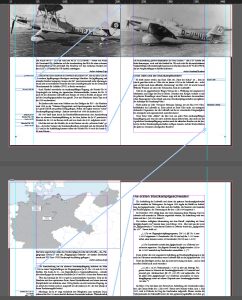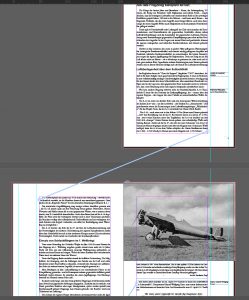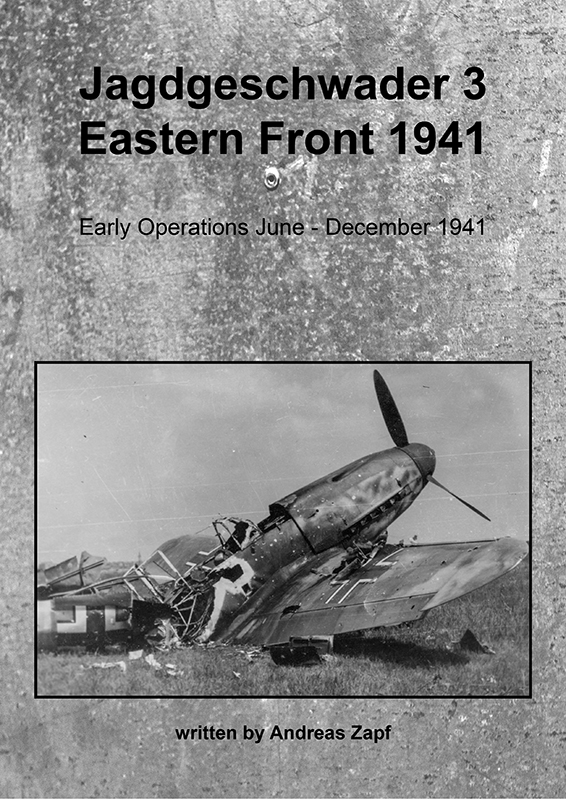For quite a while now, I have been collecting data and photos to create an updated version of a Stuka unit’s history: Sturzkampfgeschwader 77. I know there is “some stuff” out there but as always, I have a long-time goal: to create a book that allows the readers to trace the sources, draw their own conclusions and have a starting point to do some digging of their own if they want to.
My data comes from three different personal sources as well as the official Bundesarchiv/Militärarchiv in Freiburg. Now it is time to get going – the writing has started. So what does that mean? How does a book on a topic like that evolve? Well, certainly not “over night”.
First of all, the writing of a book like that starts with the planning – you cannot just “jump in” but then, if you want to provide an introduction to the topic, you need to carefully balance the reader’s need for background information vs. the actual topic of the book.
I am writing my books straight in Adobe InDesign – the reason simply is that I will use it later to create the printable PDF Files. The downside is that InDesign is great for the layout of the text and the images but does not offer much in terms of text analysis and so on.
This issue, however, can be overcome by transferring the text into other authoring software packages such as Papyrus Author if one wants to use these features.
My text is organized in chapters and each chapter is a dedicated Adobe InDesign file – that way, I can track the status of parts of my text (e.g. draft, proof-read, final, etc.) while working on other areas of the book. It is also easier to move chapters around or – if the size grows too large – to split into more than one volume.

The most important thing in the beginning is to write – of course, the writing should make sense but at this time, I don’t really care about cross-checking with other sources, etc. I am setting out to draft the text, mostly I will follow one source (e.g. the files retrieved from the military archives or the diary of a pilot or something alike) and only if my first draft is written, I will double-check with other sources, amend and correct as required and bring additional aspects into the game.
This way, I may have more work but at the same time, I am reading my own text over and over again, constantly fine-tuning it as required. It’s some kind of “polishing” the work.
One very important thing is sources. The more you write and the longer your text gets the more difficulties you will have to remember your sources. I am trying to mark my source as a footnote right away – when I come back later, I don’t have to remember where I took my wisdom from, I can simply look it up.
The other important part of the book – next to the text – is the images. Either photos or graphics. I am trying to place both types as early as I can. That way, I can get a really good idea of stuff missing (or also noting where I am having too much).
Photos are one thing – the biggest challenge is finding one that fits your needs – both in content and size (and of course, all my photos are either received from friends or I own the original – no “stealing” from the Internet!)
Graphics are more cumbersome – mine are “hand-drawn” or at least custom created. Like the map you see in the second screenshot above. These are mostly done in Adobe Illustrator and it can take hours (actually, countless hours!) to create them. All of these are custom, vectorized drawings that cannot be found anywhere out there: custom coastlines (yes, they were different in the 1930s and 1940s!), custom borders (they certainly were different and changed quite a bit!), and custom labels – the maps need to show exactly the information you want to transport – everything else just “clutters” it.
With a chapter finished, it goes out to some friends. Some of them are doing the proof reading just for the typos and grammar – and general readability. Others are looking into the content in terms of completeness and correctness. I am typically running with a handful of people supporting me. And I am lucky they are willing to help and render their support (which also costs them quite a bit of their own time).
So you can see – there is quite a bit of work ahead – but it has started moving. So stay tuned, I will keep you updated on the progress 🙂


